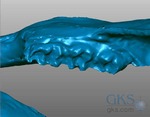We’ve all been to the dentist (you have gone, haven’t you?) and from time to time we need to get replacement teeth or portions thereof. The dentist makes you bite into rubber or plastic moulds to capture the 3D shape of the required parts and then sends it off for custom manufacturing. But Is there a different way to do this?
GKS 3D Scanning has an interesting article describing their experience in this area. Here’s some of their unique applications:
- The “bite mould” can be laser-scanned to produce a highly accurate 3D model of the required tooth. The 3D model can then be produced on a variety of equipment using different print media. (We strongly recommend staying away from Shapeways Bronze for this application!)
- Orthodontics can benefit from repeated laser scans that can detail the progress of tooth movement throughout the use of braces and retainers.
- Toothbrush design can be optimized by 3D scanning many sets of teeth to produce the “average” mouth size and shape.
- Digital storage of patient’s mouth scans take up far less space in the office than the traditional plaster casts.
- Archival 3D casts of your teeth provide a model for future repairs when you’ve lost some of your teeth in a barroom dispute, or simply from nervous tooth-grinding. Just scan again and 3D print the difference.
These ideas and much more can be seen at GKS’s website.



I wonder if dental scans could also aid in the identification of a skeleton in the same way x-rays are used?
Joseph
Why produce a toothbrush optimized for the "average" mouth… why not print custom toothbrushes optimized for your mouth?
-S